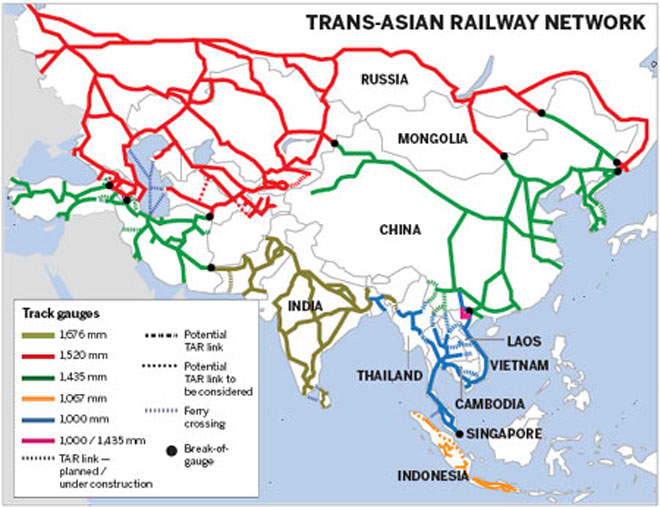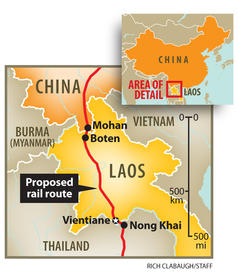Future project of a Trans-Asian Railway for the next decade

Take the train from London to Singapore or ride by car from Tokyo to Istanbul in Turkey, a utopia you will tell me. Yet the day it will be possible to undertake this journey is not so far away. Following the completion of Asian Highway Network Caravan and the Trans-Asian Railway TAR will be completed too and all that was mentioned above will be possible. Initiated in the 60s by the Economic and Social Commission for Asia Pacific (UNESCAP), the project has never been talked this much. The Chinese have also begun their high speed train project in the city of Kunming to Thailand.
Following the vast movement of European unification, globalization, free trade, its booming economy and the opening of several closed countries, the project has never been so close to a real takeoff. There are still many problems to solve before this vast network linking Europe to Asia becomes a reality.
Asian Highway Network Caravan
The Asian Highway Network Caravan will connect existing and new roads from Tokyo , Bangkok and Istanbul to connect Asia to Europe. The corridor aims to promote exchanges and develop infrastructure in the poorer countries within a 50 years agenda. An agreement was signed in Shanghai in 2004 by several Asian countries to achieve this mammoth task.
[youtube]http://www.youtube.com/watch?v=klXn-0VsAv0[/youtube]
The Trans-Asian Railway (TAR)
The Trans-Asian Railway was initiated in the 60s with the aim to provide a continuous rail link of 14 000 km between Singapore and Istanbul with the possibility of being connected to networks in Europe and Africa. This would significantly shorten the transit time between countries and regions to become a catalyst for international transportation as a tool for business expansion, economic growth and cultural exchange.
Countries that are potentially connected to this network are: Armenia, Azerbaijan, Cambodia, India, Indonesia, Iran, Kazakhstan, Laos, Mongolia, Nepal, China, South Korea, Russia, Sri Lanka, Tadjikstan, Thailand, Turkey, Uzbekistan and Vietnam. The network plans to borrow three corridors of different magnitudes and small branches.
For example, the Nordic corridor will be linking northern Germany, Poland, Belarus, Russia, Kazakhstan, Mongolia, China and South Korea. Currently, 8.300 km are still missing the call. It will not be easy to fund and get along with everyone to bring this project to fruition. Several countries are poor and governments are not always democratic and transparent. Countries such as Laos and Cambodia, to name a few, have a lot of work to do before actually being part of the project.
Cambodia is one of many railroads who do not exist in the proposed Trans-Asian Railway (TAR). It must have a system restore which has been abandoned for decades. Only one train was still traveling in Cambodia until 2010, but has now ceased its operations. It was in a poor condition. The train’s frequency was only once a week at a speed of 20 km per hour.
[dailymotion]http://www.dailymotion.com/video/x6ojs3_cambodge-bamboo-train-norry_travel[/dailymotion]
Today only the bamboo trains and homemade vehicles carry food and people. They are operated by adapted water pumps.
In 2009, the Asian Development Bank has provided $ 84 million to rebuild the rail network of 600 kilometers of Cambodia. The entire project should cost $ 141 million and was due to be completed by 2013, but all indicated that the project is still not under construction.
Chinese controversial project of TGV between Kunming and Laos
China tries to get ahead with its high speed rail project linking China, Laos and Thailand. Discussed at length, this train promises to be a major economic link for a hundred million people. The exact route is not yet clear, but it is expected that the line connecting the Chinese city of Kunming to Singapore via Malaysia and its neighbors.
Laos, the least developed country in East Asia, sees the proposed railway as the key to open up its borders and monetize its abundant natural resources. This project became a priority in the agenda of the Lao government. Laos has only two kilometers of railway track; the authorities anticipate a high speed train built by the Chinese could bring tourism, casino gamblers and employment to its population in great need.
[youtube]http://www.youtube.com/watch?v=Qp21XiC46yA[/youtube]
Tension mounts between Chinese immigration and the Lao
This project does not please everyone in the population. Many Laotians are afraid that the Chinese come to appropriate their land and natural resources in exchange. The Chinese have already invested millions to help Laos build a stadium for the South Asian games in 2009. The Chinese would seem to have obtained favors in return from the Lao government.
« We read that after the stadium built by the Chinese for Asian Games South East was completed, China was supposed to move 50,000 people in Laos. The government has denied the rumor, but it happens for real. They moved them somewhere, hidden in the country,” an elder of Vientiane.
[vimeo]http://vimeo.com/18262522[/vimeo]
Many residents are afraid, because with a population of only 5 million, if China can move enough people. They will have the country for free.

There are already many problems in the north near the Chinese border. Chinese investors have already caused quite a stir with their casino, which was established on land where the villagers have historically cultivated corn and vegetables. Known as the golden city, the casino has attracted thousands of Chinese players and has created jobs for local residents. But last year, the board began after casino operators have refused to let the players in debt to go home. Most gambling operators have since closed down under pressure from the Chinese government, leaving hundreds of Laotian casino dealers unemployed.
The area near the former Golden Triangle is experiencing a resurgence of drug trafficking and murder in connection with gambling and smuggling. Gangs and mafias from China, Burma, Thailand and Laos lead a fight for the control of smuggling across borders.
Several Lao call this phenomenon « ghost invasion » Immigrants are driven by the Chinese government. More particularly near the border. They build their own city in Huay Xai with all the posters and signs only in Chinese.
The construction of the train seems to have started, but quickly stopped because of several controversies. Seems that Laos could not provide enough food for workers. Some say the Chinese government has demanded an exclusive use of land and resources within a few kilometers of the route taken by the train. Apparently by chance, high valuable resources are located on much of his road
In conclusion, the proposed trans-Asian railway is fantastic on paper ; connecting Asia to Europe by road and a railway on a network of thousands of kilometers uniting dozens of countries economically and culturally. The problem is that rich countries will finance the poorest and they will not do it without making large profits. At the end, who will really benefit from this project? Today countries like Laos may be economically poor but culturally rich and rich in natural resources. After the passage of the train, will the villagers still be able to grow their rice and fish their own fish? Or they will have to buy it at high prices from newly arrived foreigners? Will the train stop there for anything other than boarding resources to sell to wealthier countries? Progress is not always synonymous of wealth and three meals a day for all.


POST A COMMENT.
Vous devez vous connecter pour publier un commentaire.